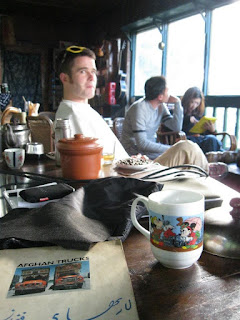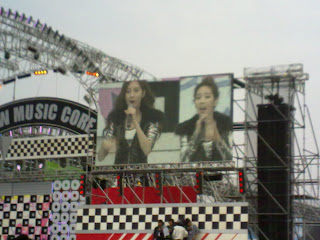One evening in late 2011, I found myself in a small hostel
located on the side of a Himalayan mountain in rural China. Something was about
to happen which wouldn't quite make sense: a niggling mystery-itch that you can't quite scratch, one that curiously involved the music of The Cranberries, and one that would only be resolved seven years
later.
That night I had a guitar in my hands and was singing songs
with my two friends and a handful of backpackers we’d just met. The hostel was
aptly named the Higherland Inn, and was perched on the hiking trail between the
historic town of Dali below, and the 4000-metre peak of Cang shan above. Finding ourselves in this beautiful corner of
the world, my friends Phil and Lisa and I were feeling lucky.
 |
| Left: Phil on arrival at the Higherland Inn. Right: our moody host playing on her tablet |
The hostel was, is, tiny. That night there were only about half a dozen guests – foreign hikers
and/or lost souls – who, having just enjoyed an amazing dinner made by our
hosts, were now sitting on the sofas, singing songs and getting to know each
other. Our hosts, a young Chinese couple, were not. They were sat at the other
side of the lounge room, playing on their tablets in silence, utterly uninterested
in our impromptu gathering. The woman especially seemed distant, aloof, almost medically incapable of smiling.
To be fair, maybe they’d seen it all before and couldn’t be
bothered to get involved with us even though several of our group could speak
mandarin. I guess we looked like the over-excited foreigners we were. They were
just at home, doing their job.
But it felt wrong, awkward. I asked Phil, who has spent many
years in China, what songs might provoke a reaction from them. We’d already
played the songs which had become tried and tested ice-breakers on our
travels (Oasis, the Beatles, Queen etc…) yet the couple hadn’t batted an
eyelid. Surely, despite the cultural chasm between us, there had to be some song that could bridge the gap, if not
between East and West, then at least between our ends of the room?
Someone said that the film ‘Titanic’ had been a huge hit in
China. Could I sing ‘My Heart Will Go On?’? Hmm. Somehow, from pieces of memory
I didn’t realise I had, I worked out the guitar chords to Celine Dion’s
timeless melody and, between us, we managed to make it sound like a song.
The couple, especially Miss MardybumFace, loved it. For the first
time since we’d arrived I saw her smile. She came over and sang along,
obviously as amazed as I was that we were sharing something. The song felt cheesy and ridiculous to me, but she was genuinely enjoying it.
But then the song finished. After the applause, she
returned to her corner of the room. Her tablet came out again. The Great Wall between us
was re-erected. We had to get rid of
it! Searching our heads for inspiration, I suddenly recalled seeing ‘Dreams’ by
the Cranberries on a Chinese karaoke bar song-menu, a week or two before. Dreams was far more familiar to me. It's a song from my youth, and unlike our
Celine, I actually liked it.
And it worked even better.
Mardybum smiled again, sang along to the melody (although it seemed she had different
lyrics?), and when the song finished – after I’d extended it for as long as I
possibly could – she brought over a bottle of rum to express the thanks and
perhaps the shock she couldn’t really express in words. We had done it! She stayed with us, still smiling, and we
drank, and we drank…
The next day Phil and I – joined by a new backpacker friend
Patrick – made an early and rather painful start to our hike up to the snowy
peak of Cang shan, terribly under-prepared and horrendously hungover. Our
survival of that mountain, altitude sickness and a blizzard, is another story
in itself.
 |
| Me, Phil, Patrick going up Cang shan. |
What stayed with me for months and years later was a question: Why
did that sulky young lady from rural China go so mad for a song by the Cranberries? It was not until
January this year that this niggling mystery was finally solved.
When in January Delores O’Riordan, the Cranberries singer-songwriter
died unexpectedly aged 46, I, like many other people, was shocked and sad. And of course, I
was reminded of that evening in China so long ago.
Among the obituaries and
tributes to Delores I read, my curiosity was piqued when I came across a BBC article titled ‘Dolores O'Riordan and Asia's enduring love
for The Cranberries’. I kind of knew that the band had a following in South Korea, but it turned out that they were pretty big in Malaysia,
the Philippines, Singapore, and Japan. It also turned out that a chinese singer called Faye Wong recorded a cover version of Dreams,
translated the lyrics into Cantonese, re-named it ‘Dream Lover’, and it was a hit in Hong Kong and mainland China in the early 1990s - about the time when Little Miss Mardy would have been a teenager. Boom.
You can watch a slightly bizarre live performance of it
here, and you’ll note that Wong’s version is faithful to the original. Somehow,
despite it being sung in Cantonese by a Chinese singer wearing possibly
ill-advised Indian headdress in front of some random cartoon
visuals, the melody and emotion of O’Riordon’s original is still intact. It’s
pretty good. Wong's version created an interest in the original, and the Cranberries eventually came to play to their many fans in China in 2011. The China Daily even wrote an obituary following O'Riordon's death this year.
All of this was news to me. But the main thing I took away was the satisfaction of
finally understanding why that song had put a smile on the face of our implacable
Chinese host, on that night up that mountain seven years ago, and why she was singing different words.
It
just shows what a funny old globalised world we live in, and just how far in both time and space a good song can
travel.
RIP Delores, and thanks.
X
X






















